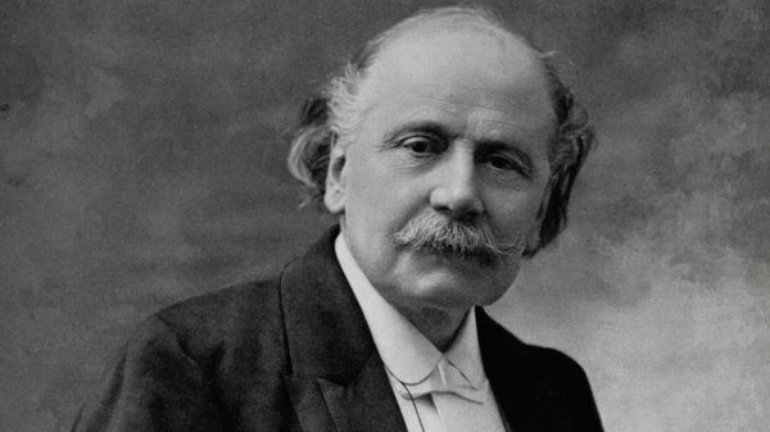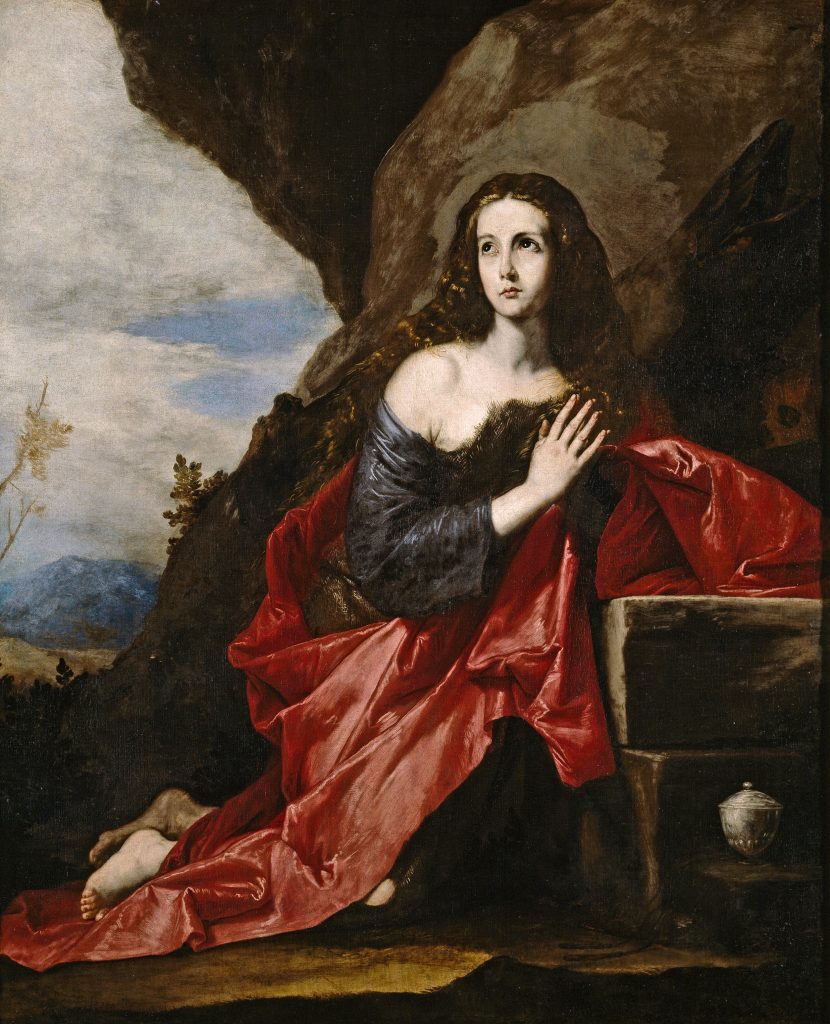
“Thais” Meditation


Thaïs is a novel by French writer Anatole France, published in 1890. It is based on events in the life of Saint Thaïs of Egypt, a legendary convert to Christianity who is said to have lived in the 4th century.[1] It was the inspiration for the opera of the same name by Jules Massenet.
Paphnuce, an ascetic hermit of the Egyptian desert, journeys to Alexandria to find Thais, the libertine beauty whom he knew as a youth. Masquerading as a dandy, he is able to speak with her about eternity; surprisingly he succeeds in converting her to Christianity. Yet on their return to the desert he becomes fascinated with her former life. She enters a convent to repent of her sins. He cannot forget the pull of her famous beauty, and becomes confused about the values of life. Later, as she is dying and can only see heaven opening before her, he comes to her side and tells her that her faith is an illusion, and that he loves her. ~ Source https://en.wikipedia.org/wiki/Thaïs_(novel)#cite_note-2
St. Thaïs reportedly lived during the fourth century in Roman Egypt. Her story is included in hagiographic literature on the lives of the saints in the Greek church. Two such biographical sketches exist. The first, in Greek, perhaps originated during the fifth century. It was translated into Latin as the Vita Thaisis [Life of Thaïs] by Dionysius Exiguus (Dennis the Little) during the sixth or the seventh century. The other sketch comes to us in medieval Latin from Marbod of Rennes (d. 1123). Thaïs also appears in Greek martyrologies by Maurolychus and Greven, however, not in Latin martyrologies. The lives of the desert saints and hermits of Egypt, including St. Thaïs, were collected in the Vitae Patrum [Lives of the Desert Fathers]. ~Source: https://en.wikipedia.org/wiki/Tha%C3%AFs_(saint)
Jules-Émile-Frédéric Massenet, (born May 12, 1842, Montaud, near Saint-Étienne, France—died August 13, 1912, Paris), leading French opera composer, whose music is admired for its lyricism, sensuality, occasional sentimentality, and theatrical aptness.
The son of an ironmaster, Massenet entered the Paris Conservatoire at age 11, subsequently studying composition under the noted opera composer Ambroise Thomas. In 1863 he won the Prix de Rome with his cantata David Rizzio. With the production in 1867 of his opera La Grand’ Tante (The Great Aunt), he embarked on a career as a composer of operas and incidental music. His 24 operas are characterized by a graceful, thoroughly French melodic style. Manon (1884; after Antoine-François, Abbé Prévost d’Exiles) is considered by many to be his masterpiece. The opera, marked by sensuous melody and skilled personification, uses leitmotifs to identify and characterize the protagonists and their emotions. In the recitatives (dialogue) it employs the unusual device of spoken words over a light orchestral accompaniment. Also among his finest and most successful operas are Le Jongleur de Notre-Dame (1902), Werther (1892; after J.W. von Goethe), and Thaïs (1894). The famous “Méditation” for violin and orchestra from Thaïs remains part of the standard violin repertory.
Several of Massenet’s operas reflect the succession of contemporary operatic fashions. Thus, Le Cid (1885) has the characteristics of French grand opera; Le Roi de Lahore (1877; The King of Lahore) reflects the Orientalism—a fascination with Asian exotica—that was also prevalent in the 19th-century European and American art market; Esclarmonde (1889) shows the influence of Richard Wagner; and La Navarraise (1894; The Woman of Navarre) is influenced by the end-of-the-century style of verismo, or realism. Also prominent among Massenet’s operas are Hérodiade (1881) and Don Quichotte (1910).
Of Massenet’s incidental music, particularly notable is that for Leconte de Lisle’s play Les Érinnyes (1873; The Furies), which contains the widely performed song “Élégie.” In 1873 he also produced his oratorio, Marie-Magdeleine, later performed as an opera. This work exemplifies the mingling of religious feeling and eroticism often found in Massenet’s music. Massenet also composed more than 200 songs, a piano concerto, and several orchestral suites. ~ Source https://www.britannica.com/biography/Jules-Massenet
Jules Massenet (1842-1912) was een van de populairste operacomponisten van zijn tijd. Ook over de Franse grenzen had hij invloed, met name op Italiaanse operacomponisten als Puccini en Mascagni. Veel critici hebben hem deze populariteit niet in dank afgenomen. Ze beschuldigden hem ervan alleen het publiek te willen plezieren; hij zou zich schaamteloos overgeven aan exotisme en zijn succes slechts te danken hebben aan zijn gave mooie melodieën te kunnen componeren. Dit weinig flatteuze beeld is inmiddels wel achterhaald. Massenet, componist van zulke uiteenlopende opera’s als Manon, Werther en Thaïs, gaf zich niet over aan blind formulewerk. Hij leerde de operatekst van buiten voordat hij aan de slag ging en componeerde de muziek in zijn hoofd. Met als resultaat dat weinig componisten hem kunnen overtreffen in de helderheid en subtiliteit van zijn orkestraties en in de nuances van zijn woordzettingen. Hij betovert niet alleen in aria’s, maar ook in recitatieven en arioso-passages. Hij was een meester in het uitbeelden van couleur locale en is de componist van onsterfelijke melodieën als de Méditation uit Thaïs voor viool en orkest en de Élégie voor cello en orkest. (CP) ~Source: https://www.muziekweb.nl/Link/U00000584991/CLASSICAL/Tha%C3%AFs

Clara-Jumi Kang: Massenet, “Thais” Meditation (Encore) 06 APR 2018, Symphonic Festival 2018 Seoul Arts Center Seoul Philharmonic Orchestra Shi Yeon Sung, Conductor
Jules Massenet Thais Meditation Classic FM M-Tel Radio Symphony Orchestra 13 March 2006 NDK Sofia MAXIM VENGEROV, Violin Conductor: Luciano Di Martino
Jules Massenet – Mélodie – Elégie, Op. 10 Nº 5.
Cello – Mischa Maisky, Piano – Pavel Gililov Elegy is a form of poetry natural to the reflective mind. It may treat of any subject, but it must treat of no subject for itself; but always and exclusively with reference to the poet. As he will feel regret for the past or desire for the future, so sorrow and love became the principal themes of the elegy. Elegy presents every thing as lost and gone or absent and future. O sweet springtimes of old verdant seasons You have fled forever I no longer see the blue sky I no longer hear the bird’s joyful singing And, taking my happiness with you You have gone on your way my love! In vain Spring returns Yes, never to return The bright sun has gone with you The days of happiness have fled How gloomy and cold is my heart All is withered Forever Jules Émile Frédéric Massenet ; 12 May 1842 – 13 August 1912, was a French composer of the Romantic era best known for his operas, of which he wrote more than thirty. The two most frequently staged are Manon (1884) and Werther (1892). He also composed oratorios, ballets, orchestral works, incidental music, piano pieces, songs and other music. While still a schoolboy, Massenet was admitted to France’s principal music college, the Paris Conservatoire. There he studied under Ambroise Thomas, whom he greatly admired. After winning the country’s top musical prize, the Prix de Rome, in 1863, he composed prolifically in many genres, but quickly became best known for his operas. Between 1867 and his death forty-five years later he wrote more than forty stage works in a wide variety of styles, from opéra-comique to grand-scale depictions of classical myths, romantic comedies, lyric dramas, as well as oratorios, cantatas and ballets. Massenet had a good sense of the theatre and of what would succeed with the Parisian public. Despite some miscalculations, he produced a series of successes that made him the leading composer of opera in France in the late 19th and early 20th centuries. Like many prominent French composers of the period, Massenet became a professor at the Conservatoire. He taught composition there from 1878 until 1896, when he resigned after the death of the director, Ambroise Thomas. Among his students were Gustave Charpentier, Ernest Chausson, Reynaldo Hahn and Gabriel Pierné. By the time of his death, Massenet was regarded by many critics as old-fashioned and unadventurous although his two best-known operas remained popular in France and abroad. After a few decades of neglect, his works began to be favourably reassessed during the mid-20th century, and many of them have since been staged and recorded. Although critics do not rank him among the handful of outstanding operatic geniuses such as Mozart, Verdi and Wagner, his operas are now widely accepted as well-crafted and intelligent products of the Belle Époque. Elegy is a form of poetry natural to the reflective mind. It may treat of any subject, but it must treat of no subject for itself; but always and exclusively with reference to the poet. As he will feel regret for the past or desire for the future, so sorrow and love became the principal themes of the elegy. Elegy presents every thing as lost and gone or absent and future. The Élégie by Jules Massenet (1842-1912) was perhaps one of the most popular melodies in Europe of the fin de siècle, the last decades of the nineteenth century, often referred to as the Belle Epoque. Massenet originally composed Élégie in 1866 for a piano cycle titled Pièces de Genre, Op. 10 Nº 5. In 1872, he incorporated the piece into Les Erinnyes (The Furies), a play by Leconte de Lisle. The sorrowful melody for muted cello became a solo piece entitled Mélodie-Elégie and was arranged numerous times for many instruments and instrumental ensembles. At some point it was adapted to the lyrics ‘O doux printemps d’autrefois’ by Louis Gallet (1698?-1757). The present arrangement by the Catalan guitarist Jaime Bosch (1826-1895), mainly known in France as Jacques Bosch, was published in 1891 in Paris by the Vve. E. Girod, the successor of the original publisher of the cello and piano version, E. et A. Girod, 16 Boulevard Montmarte (pl. nr. 5499). The guitar arrangement seems to have been a hastily prepared edition, employing the original cover page of the cello and piano edition, with a new rubber stamp marking it as Edition pour Guitare (pl. nr. 6203). The guitar version does not contain any dynamics and articulations, and skips the initial two measures of Introduction played originally on the piano. The paucity of fingering indications is at a great contrast to other guitar editions of the period. The present edition is fully fingered, contains all the dynamics markings from the original edition, and the missing two bars of the Introduction have been added editorially.
